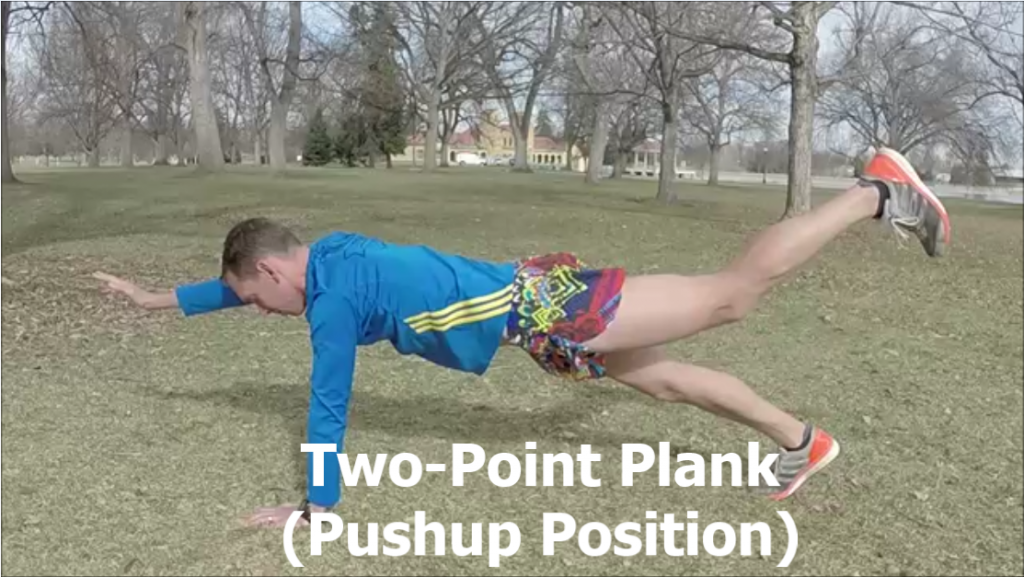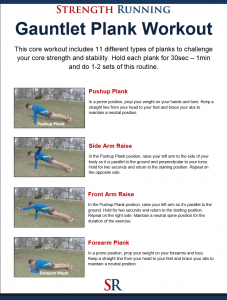When you were a kid, you probably did sit-ups for an ab workout. But is the sit-up the best ab exercise?

That’s actually a simple question: the answer is no way! There are far better ab exercises than a simple sit-up, which can exacerbate back problems and only focuses on one small area of the abdominals.
And while you’ll develop tremendous ab strength by doing heavy squats, dead lifts, and other traditional weightlifting exercises, not all of us can throw around heavy iron at the gym.
Luckily for us runners, there are a variety of plank exercises that helps us build the core strength necessary for more efficient running form and fewer overuse injuries.
The plank is a versatile exercise as it strengthens the:
- Rectus Abdominus (these are what you see if you have six-pack abs)
- Internal and external obliques (the part of your abs on the side of your torso)
- Transverse Abdominus (the deepest part of your abs that support your spine)
- Hips (always important for runners)
- Back (particularly important for runners, especially the lower back)
- Glutes (strength is good – a shapely booty is a nice bonus!)
If you regularly do a plank workout, you know how simple they are. They can be done virtually anywhere and require no equipment. They’re perfect for beginners – and even the fastest of runners.
No matter what race you’re training for or your ability level, planks are a fantastic ab exercise to incorporate into your core strengthening program.
I do them regularly as part of the Standard Core Routine.
And they’re included in many other strength and core routines that are critical to injury prevention.
But the standard plank only gets you so far. After about 1-2 months, your fitness gains will plateau and you’ll stop getting as much strength from this exercise.
What you must do is progress to more difficult variations of the exercise to continue getting stronger.
So I’m excited to introduce a new video (and free PDF download) showing you 11 tpes of planks!
Introducing: The Gauntlet Plank Workout
For days when you’re short on time, Gauntlet is a good option: with 11 time-based exercises, you can do each one for just 30 seconds and still get in a solid core workout.
Here’s the full Gauntlet Plank Workout:
Here’s a text description for each type of plank exercise:
1. Pushup Plank
In a prone position, prop your weight on your hands and toes. Keep a straight line from your head to your feet and brace your abs to maintain a neutral position.
2. Side Arm Raise (in Pushup position)
In the Pushup Plank position, raise your left arm to the side of your body so it is parallel to the ground and perpendicular to your torso. Hold for two seconds and return to the starting position. Repeat on the opposite side.
3. Front Arm Raise (in Pushup position)
In the Pushup Plank position, raise your left arm so it’s parallel to the ground. Hold for two seconds and return to the starting position. Repeat on the right side. Maintain a neutral spine position for the duration of the exercise.
4. Forearm Plank
In a prone position, prop your weight on your forearms and toes. Keep a straight line from your head to your feet and brace your abs to maintain a neutral position.
5. Pushup Plank Shuffle
In the Pushup Plank position, take two steps to the left and then two steps to the right. Alternate with your left arm and right leg and then your right arm and left leg.
6. Forearm to Pushup Plank
Begin in the Pushup Plank position and carefully lower yourself to the Forearm Plank position. Alternate positions for the duration of the exercise.
7. Spiderman Plank
In the Pushup Plank position, bring your left knee to your left elbow and hold it for about two seconds. Return to the starting position and repeat with your right leg.
8 Alternating Leg Lifts (Pushup)
In the Pushup Plank position, raise your left leg about 12-18” off the ground. Hold for two seconds and return to the starting position. Repeat on the opposite side. Ensure good form by maintaining a braced, neutral spine position and activating the glutes to help lift your leg.
9. Two-Point Pushup Plank
In the Pushup Plank position, raise your left leg off the ground while lifting your right arm at the same time. Your left leg should be about 12-18” off the ground and your right arm should be parallel to the ground. Hold for about 2 seconds and then return to the starting position. Repeat with the opposite leg and arm.
10. Alternating Leg Lifts (Forearm)
In the Forearm Plank position, raise your left leg about 12-18” off the ground. Hold for two seconds and return to the starting position. Repeat on the opposite side. Ensure good form by maintaining a braced, neutral spine position and activating the glutes to help lift your leg.
11. Two-Point Forearm Plank
In the Forearm Plank position, raise your left leg off the ground while lifting your right arm at the same time. Your left leg should be about 12-18” off the ground and your right arm should be parallel to the ground. Hold for about 2 seconds and then return to the starting position. Repeat with the opposite leg and arm.
Plank Workout Q&A
This type of core workout is incredibly versatile. But with that flexibility there’s bound to be questions, so let’s dive in!
How long should I do each plank?
As long as you want! The beauty of this plank workout is that each exercise can be done for a short period of time for an easier strength session – or longer to increase its difficulty.
My recommendation is to hold each exercise for about 30 seconds to 1 minute.
How many sets of this plank workout should I do?
Start with one but you can increase that to two or even three sets if you’re ambitious. There’s virtually no injury risk with planks so don’t worry about getting hurt.
What if I can’t do one of the planks?
No problem! The beauty of this plank workout is that it can be used by beginners or advanced athletes. Just skip the plank you can’t do or do an easier version.
For example, if you can’t do a two-point forearm plank, then try a two-point pushup plank.
Still too hard? Try an alternating leg lifts plank in the forearm position. STILL too hard? Then do an alternating leg lifts plank in the pushup position.
By reducing the complexity of the exercise and moving from the forearm to pushup position, you can decrease the plank’s difficulty.
Is the order of the exercises important?
The order of the planks in the Gauntlet Workout are roughly ordered from easiest to most difficult (though many of the planks are of a similar difficulty level).
So by doing them in the order that they’re presented, you accomplish two goals:
- You help yourself gradually warm up into the workout
- You essentially “negative split” the workout by doing the most difficult exercises last
You don’t need to do this plank workout in this exact order but I do recommend it.
When should I do the Gauntlet Plank Workout?
This core routine is best done after your run about once or twice per week. It can also be done throughout your entire training cycle.
Be sure to alternate with other strength workouts like the ITB Rehab Routine or Tomahawk Medicine Ball Workout.
Why is it called the ‘Gauntlet’ Workout?
All of the core and strength routines in Injury Prevention for Runners are named after medieval weapons (for the sole reason that they’re interesting names!). This tradition is continued with the Gauntlet Plank Workout.
If you’d like more information on Injury Prevention for Runners (Strength Running’s most popular training program), just sign up here.
Download the photo guide to this routine!
I know you absolutely love watching me perform these exercises in my split-leg 1″ short shorts… But if you’d like a handy PDF with photos of each exercise and written descriptions, I understand 😉
Just sign up here and it’ll be on its way.
You can refer to it whenever you’d like, hang it in your gym, or make the most stylish paper airplanes.
It’s more convenient – and will hopefully encourage you to do more strength work!